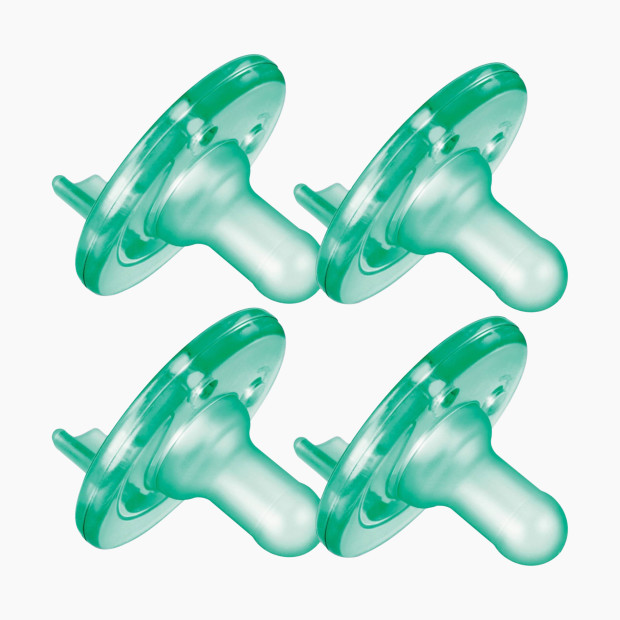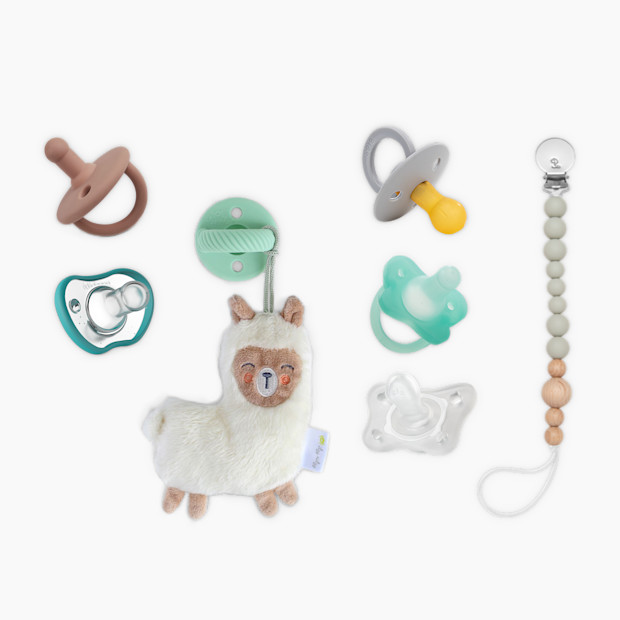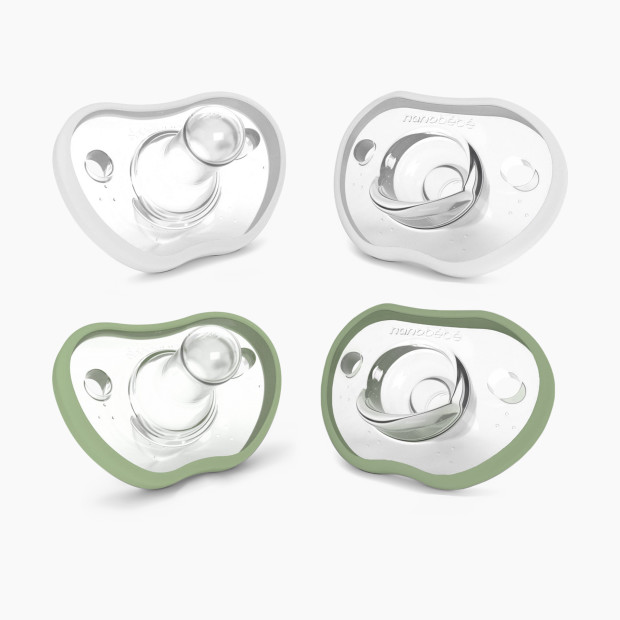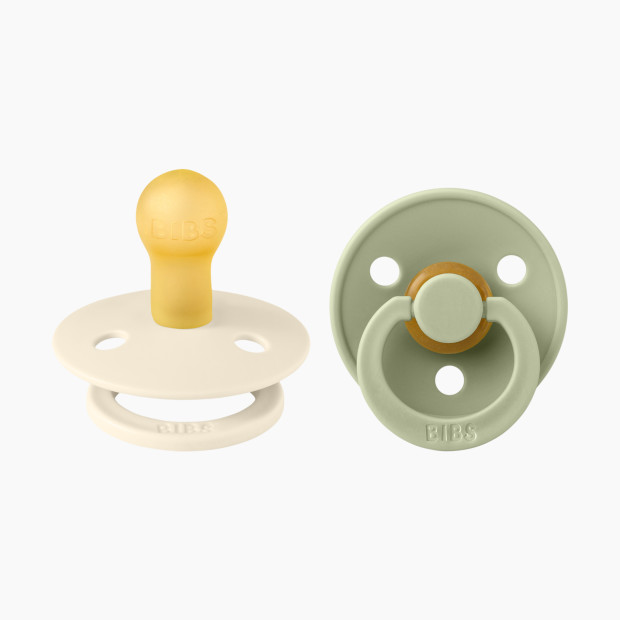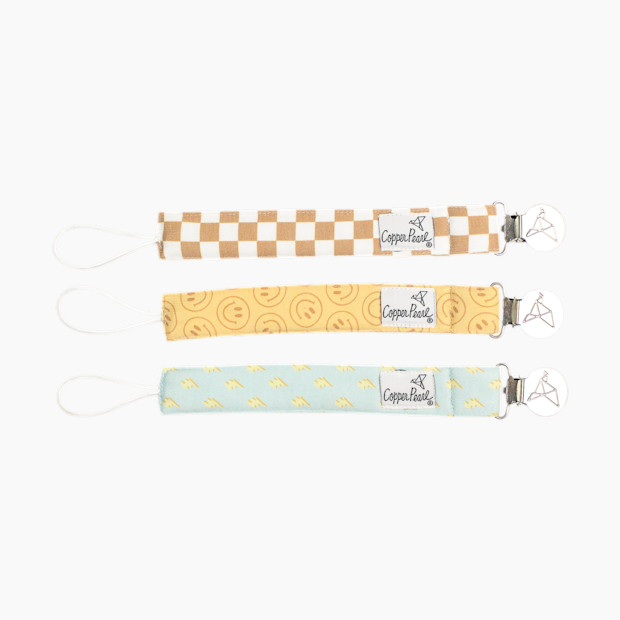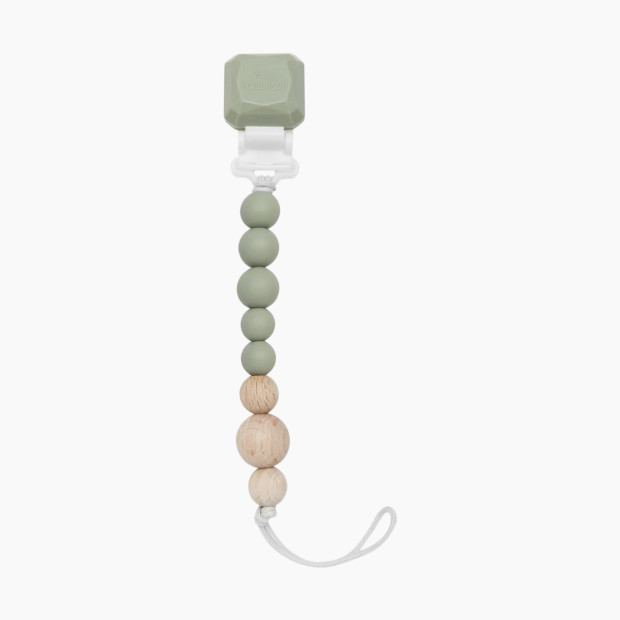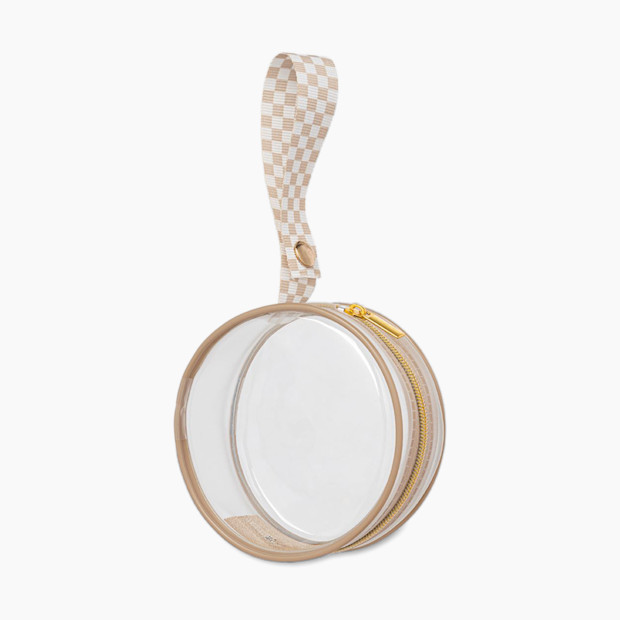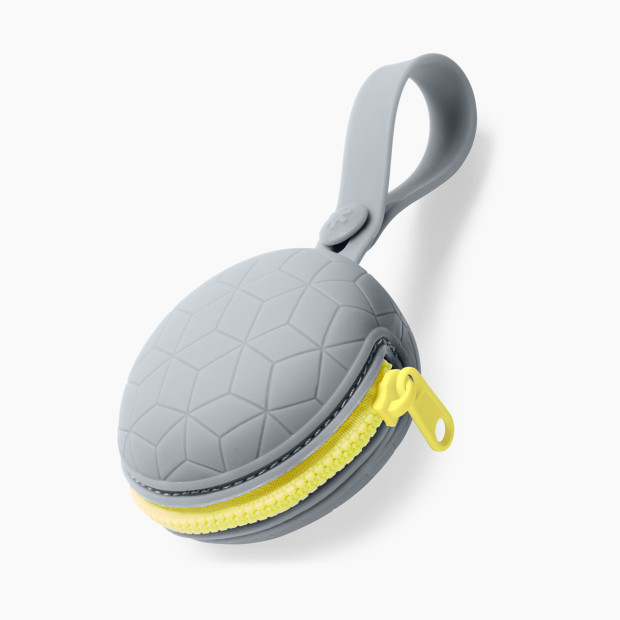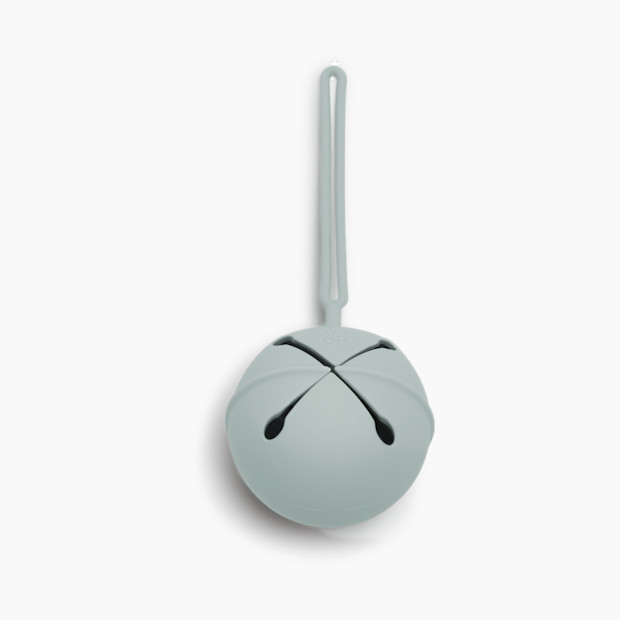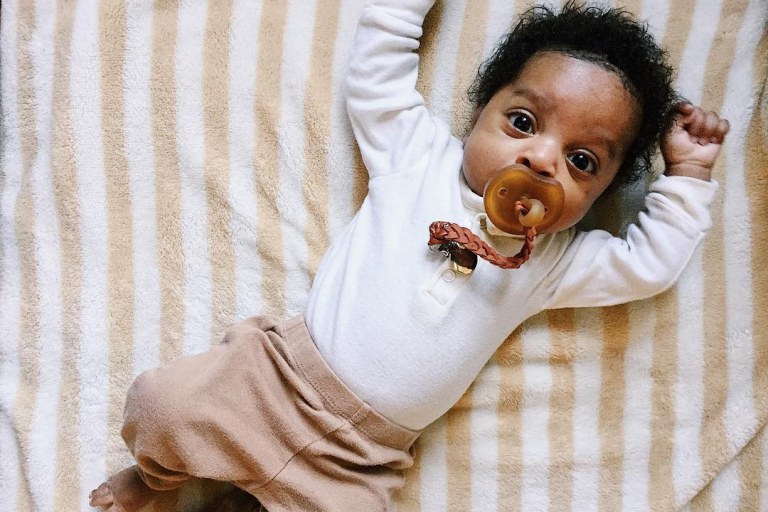
The Best Pacifiers to Soothe Your Baby, According to Experts & Real Parents
You can soothe a fussy baby fast with the right pacifier, but there are a lot to choose from. We’ll help you decide.

By Briana Engelbrecht and Jen LaBracio, CPST
Medically Reviewed by Brittany DiBardino DO
Fact Checked by Shannon Vestal Robson
In This Article
A pacifier can be a total lifesaver when you’ve got a fussy baby and nothing seems to be working. Babies are born with a sucking reflex, which naturally soothes them, which is probably why many parents-to-be add pacifiers to their baby registries.
But there’s also a lot of confusion around pacis: which shape is best, when’s the best time to introduce one, is the size of the pacifier important, and many more questions new parents ask themselves. And then there’s paci pickiness to contend with, because it turns out pacifiers are one of those things babies have a lot of strong opinions about. Figuring out which pacifier your baby will prefer can take some trial and error.
While all that really matters is which pacifier your baby will accept, our top pick—and the pacifier many experts and actual parents recommend starting off with—is the Philips Avent Soothie. Its rounded nipple shape, safe medical-grade silicone and one-piece design make it comfortable for babies to use and easy for parents to clean.
But as we mentioned, babies are picky creatures. So we rounded up a few other picks to find what your baby will like, no matter their preference.
Why Trust Babylist?
Babylist is the expert in baby; we know baby gear inside and out. We talk with parents face-to-face in our showroom and on our user panels and hear from thousands annually via our Best Baby Products online survey. We know what items millions of expecting parents are adding to their baby registries.
As Babylist’s assistant editor and a mom of two, I’ve personally tried many different pacifiers in my quest to get my babies to take them (neither did, and that’s ok, too). I used my insight from that experience and from what I learned after becoming a certified lactation consultant (CLC) to choose the pacifiers and categories on this list. I also leaned on insight from Jen LaBracio, Babylist’s senior gear editor, who has a decade of experience in the world of baby products and is also a parent of two young boys, ages ten and three. In addition, I spoke to a few different professionals, including Dr. Jasveen Singh, a pediatric dentist who treats tiny patients at Pediatric Dentistry and Beyond, and Dr. Whitney Casares, a pediatrician and the voice behind Modern Mommy Doc. I also spoke to Ruth Hale, a board-certified lactation consultant (IBCLC) and founder of Birth to Breast to find out what parents need to know about pacifiers and breastfeeding. And finally, I reviewed feedback from thousands of parents through Babylist’s annual Best Baby Products survey of thousands of Babylist users and talked to parents at Babylist for their input.
How We Judged the Best Pacifiers
- For Breastfed Babies
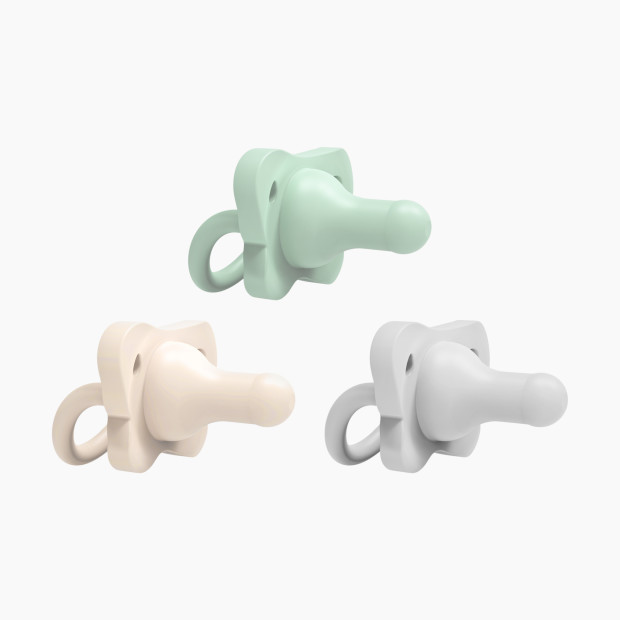 Dr. Brown's HappyPaci One-Piece Silicone Pacifier (3 Pack) - Green, Gray, EcruFrom $3.59
Dr. Brown's HappyPaci One-Piece Silicone Pacifier (3 Pack) - Green, Gray, EcruFrom $3.59
Best Overall Pacifier
Philips Avent Soothie Pacifier, 0-3 Months (4 Pack) - Green
From $8.94Pros
- Medical-grade silicone
- Affordable (about $3 a piece)
- Symmetrical nipple shape
Cons
- Bulky for small babies
The Philips Avent Soothie is our best overall pick because it checks all of the boxes we think matter the most when choosing a pacifier. It’s got a cylindrical nipple shape that most babies accept, and it allows breastfed babies to use the same mouth mechanics necessary for nursing on the boob. It’s also symmetrical, so no need to twist it around to get it in the right position. A few parents call out the finger hold feature, where you can stick your finger in the center of the nipple while baby uses the pacifier. “It [allowed] me to establish a special bond with my newborn while also providing comfort,” one parent said.
We also love that it’s one piece of medical-grade silicone, since that means there are fewer places for germs to hide. It’s easy to clean; simply toss it in the dishwasher or sterilizer. (The American Academy of Pediatrics also prefers one-piece pacifiers since there is no safety risk of them coming apart.) You might even get a free sample of this pacifier when you deliver.
One thing to keep in mind: the shield is a bit bulky; one Babylist parent said it was “too big for my baby’s face and kept falling out." The sizes are also a bit limited, with options for either 0-3 months or 3-18 months. That’s a rather large time period with a lot of growth. But if you plan to wean baby from the pacifier by their first birthday, it shouldn’t be too much of a concern.
Best for Breastfed Babies
Dr. Brown's HappyPaci One-Piece Silicone Pacifier (3 Pack) - Green, Gray, Ecru
From $3.59Pros
- One-piece soft silicone design
- Encourages cupped tongue shape
Cons
- Only for babies up to 6 months old
The nipple features that landed Dr. Brown’s bottles in both our best baby bottles and best bottles for breastfed babies guides are the same ones that make this our top pacifier choice for breastfed babies. The pacifier has the same round, symmetrical nipple (no “right side up” here) that encourages the “cupped” shape baby’s tongue takes when nursing at the breast. Since these encourage a similar latching technique to breastfeeding, many parents find that their baby not only accepts them, they help avoid or lessen nipple confusion. According to one Babylist parent, "We use Dr. Brown's bottles so I figured these pacifiers would help him because he would be familiar with the nipple shape as they are the same as the bottle nipples. While they are kind of big for his tiny face and mouth, I do see where he mimics the same sucking and pulling on these pacis as he does on the bottle and latching has been easier for him too."
They’re made from lightweight silicone that makes it easier for baby to keep in their mouth and dip below their nose for more comfortable and easier breathing. Some parents say the little handle allows their baby to grab it themselves, too. The biggest complaint among parents is that this pacifier only comes in one size (0-6 months), meaning that they’re faced with having to find a new preferred pick once they size out of this option.
Best Pacifier for Newborns
Nanobebe Flexy Pacifier (4 Pack) - Sage And White, 0-3 Months, 4
From $9.59Pros
- Sized for newborns
- Symmetrical shape
- Affordable
Cons
- Easy to lose
The flexy is super lightweight, which means your newborn can more easily keep it in their mouth. It's more than just sleek and stylish, it’s also cleverly ergonomic. Unlike other pacifiers, the Flexy has a slightly curved shield that forms to your baby’s tiny face, plus curves on the top and bottom to comfortably fit between baby’s nose and chin. The design helps the pacifier rest more naturally and snuggly against their mouth, while the vents ensure airflow to prevent sweat and buildup. The one-piece silicone design also means it’s easy to clean and sterilize. And just like the Soothie, the pacifier’s nipple is rounded (aka cylindrical).
Quite a few Babylist parents shared that their exclusively breastfed baby took to this pacifier. One Babylist parent shared, “I’m a first-time mom of a 3-week-old. We introduced pacifiers to her this week and these have worked out perfectly for us. There is no nipple confusion, and she seems to like them!” The nipple is also on the smaller side, which helps to prevent the gag reflex some babies experience when first introduced to a pacifier.
While the small size (and lightweight silicone material) is ideal for newborns, it makes it easy to lose around the house or in your diaper bag. They’re so lightweight, one parent recommends making sure they’ve got a good suction on it before moving away: “They do tend to pop out of her mouth if it’s not held for a few seconds, just because of the slim design.” Color options are also limited, which is something a few parents also mentioned.
Best Pacifier For Orthodontic Development
Pros
- Dentist-recommended nipple shape
- Easy to clean
- Heart-shaped shield fits under the baby’s nose
Cons
- Asymmetrical nipple hard to place at night
- Material attracts lint
- Hard to find in stores
One concern many parents—and dentists—have about pacifiers is their potential to affect a child’s teeth, palate and jaw development. If you wean off of the pacifier early enough (most experts recommend starting to wean between 12 and 18 months if baby shows no signs of stopping) this typically doesn’t become an issue. These are made with a sturdy, silicone material and have an asymmetrical nipple shape that’s designed with healthy oral development in mind.
Pacifier use, particularly past the age of two, can lead to dental issues like an open bite, “Where the front teeth don’t meet properly when the mouth is closed, misalignment of the teeth or changes in the shape of the roof of the mouth, which could [all] require orthodontic treatment later,” says Dr. Jasveen Singh, a pediatric board-certified dentist who takes care of tiny teeth at Pediatric Dentistry and Beyond in Massachusetts. She says that’s also why it’s important to size up your baby’s pacifier when the time comes, since using a pacifier that’s too small can affect the development of the jaw and teeth. These come in two sizes: 0-6 months and 6-18 months.
Parents' biggest complaint about these pacifiers is that the material tends to attract (and cling to) any little lint, fuzz, or pet hair that floats by it. One parent went so far as to call them “fur magnets.” Luckily, they’re super easy to rinse off and clean if you’ve got real babies and fur babies in your home. The shield is also pretty small—small enough to be a choking hazard if you’re using the wrong size for an older baby. And since the nipple is an asymmetrical shape, a few mentioned it being tricky to plug back into their baby at night because it’s hard to see which side should be facing up.
They’re also not the ideal shape to promote an easy transition between breast and pacifier. Hale, an IBCLC, says she and most IBCLCs “don’t recommend [slanted] pacifiers because they promote a low tongue posture and do not promote cupping.” If your baby is taking a bottle or breastfeeding is going well, then it should be fine to use these. But she recommends giving the Flexy or Soothie a try for babies in other situations.
Best Natural Rubber Pacifier
BIBS Natural Rubber Pacifier (2 Pack) - Sage / Ivory, Size 1
From $15.95Pros
- Natural rubber
- Tons of colors + styles
Cons
- Slight rubber smell
- Material expands over time
- Not the most ideal nipple shape
Some parents prefer to stick to natural baby products. And if you fall into that category, these are the pacis you may want to let your baby try. Designed in Denmark, these pacifiers are made from natural rubber and are 100% free from BPA, PVC and phthalates.
These pacifiers come in a wide range of colors that’ll coordinate with any outfit or swaddle blanket. (Just don’t be like me and buy ten before you know if your baby will take to them). They also make versions with different shield and nipple shapes, if your baby doesn’t vibe with this model but you’d prefer to try another rubber option. BIBS has a try-it kit so you can easily check them all out, too. Sizing is a bit different than other pacifiers—size 1 is for babies 0-6 months old and size 2 is for 6-18 months.
These pacifiers are on the pricier side, about $8 each (a little less if you buy them in the 2-pack like this). Since this is a two-piece pacifier, it’s important to regularly inspect it to make sure it’s not coming apart. It’s also not the most ergonomic nipple shape. Dr. Singh says that “cherry-shaped pacifiers can exert uneven pressure on the teeth and jaw, potentially leading to issues like an open bite.” On the flip side, some parents noted their baby had an easier time holding these in. “My baby couldn't keep any pacifiers in her mouth (Avent Soothies and ortho shaped) unless I held it for her... until these! They stay in, don’t pop out unless she wants it to,” reported one Babylist parent.
Another thing worth noting is that the natural rubber on this particular pacifier tends to expand over time. (BIBS recommends replacing every 4-6 weeks.) They’re also not dishwasher safe. You’ll need to hand wash and sterilize following the brand’s specific directions—BIBS recommends pouring boiling water over the pacifier in a bowl and letting it soak for five minutes.
Best Pacifiers for Baby Registry
Pros
- Seven different pacifiers to try
- Includes pacifier clip
Cons
- Only newborn sizes included
- Pricey
The best pacifier for your baby is the one that they’ll actually take, and Babylist’s exclusive Pacifier Box can give you a head start at success. It’s a paci “sampler pack” that comes with seven different pacifiers (and one pacifier clip) so you can take each one for a test drive with your baby to see what comes out on top—then stock up so you’ll never be without your favorite. “[Our baby] wouldn’t take the hospital paci they give so coming home to this box was so nice!” one Babylist parent shared.
The box only contains newborn-size pacifiers (think sizes like 0+, 0-3 months and 0-6 months) since it’s aimed at helping brand new babies figure out what they prefer. And although it’ll save you some money and time, the box is a bit pricey up front.
And since the limits to babies’ opinions and individuality don’t exist, here are a few honorable mentions if all of the above don’t pass your baby’s vibe check. The Tommee Tippee and MAM Original are two more great options for tiny newborns. The Itzy Ritzy Sweetie has a nipple shape similar to the Avent Soothie. We also included a few more orthodontic picks.
How We Chose Our Best Pacifiers
We analyzed results from Babylist’s Best Baby Products survey, which polled thousands of Babylist users, and asked them to share the baby products they love the most and why.
We utilized insight from the Babylist editorial team, including me, assistant editor Briana Engelbrecht, also a mom of two and a certified lactation consultant (CLC), as well as insight from gear editor Jen LaBracio, an expert in the baby space for over six years and a mom of two who has personally researched and tested hundreds of baby products, including many pacifiers. We also spoke to three experts: Dr. Jasveen Singh, a pediatric dentist, Dr. Whitney Casares, a board-certified pediatrician, and Ruth Hale, an international board-certified lactation consultant.
We reviewed information and safety guidelines from several medical sources, including the Mayo Clinic and the American Academy of Pediatrics (AAP).
We considered customer reviews from hundreds of real Babylist parents.
When Is the Best Time to Introduce a Pacifier?
When to introduce a pacifier tends to be a hot topic of discussion, particularly for those who want to breastfeed (either exclusively or the majority of the time). Some experts recommend waiting three to four weeks after your baby is born to offer a pacifier in order not to disrupt your nursing routine. But if you’re like me (and want something to help soothe your baby and give your boobs a break at night so you too can get some sleep) you’re probably wondering: what if I don’t want to wait?
“Like everything, the key is to be intentional and aim for moderation,” Hale says. “Parents who want to offer the pacifier before 4-6 weeks can choose a better shaped pacifier and set boundaries so the pacifier is a tool rather than a habit.” What does this look like in reality? If you offer a pacifier to soothe baby, remove it once they’ve calmed down. One of the main concerns with introducing a pacifier too early in the breastfeeding journey is that new parents might not be able to distinguish when their baby wants to comfort suck or when they’re actually hungry. In order to get breastfeeding off to a good start and set your supply up for the best success, you want to offer the breast as often as possible—and the pacifier use can interfere with learning this skill. However, most of the time, babies are able to successfully breastfeed and use a pacifier—if they want to, that is. Some just prefer you, and that’s totally fine as long as it works for you, too.
If you wait until four to six weeks (and once you’re in a comfortable groove with nursing) and baby refuses to take a pacifier, don’t give up right away. Some babies are downright offended the first time they experience a pacifier but many get used to them in no time. Hale recommends seeking support from an IBCLC if you’re struggling with pacifier refusal to rule out any oral dysfunctions (like tongue or lip ties, for example).
Benefits of a Pacifier
Babies are born with a sucking reflex. This need to suck is vital for eating, of course, but can also act as a soothing mechanism for most babies. Using a pacifier is a great tool for activating this reflex and working to calm your little one.
There are a few other benefits to using a pacifier with your baby:
Though the causes of sudden infant death syndrome are unknown and still being studied, there is some evidence that pacifiers might help reduce the risk, “because they maintain the tongue in a forward position in the mouth. That way, the tongue can’t block the airway,” Dr. Whitney Casares, a pediatrician and founder of Modern Mommy Doc says. Offering a pacifier at nap time and bedtime is a good place to start, as pacifiers can also help with sleep.
You can use a pacifier to distract and soothe your baby during stressful situations, like after vaccinations or during or after a medical procedure. Pacifiers are also helpful during flights as they can help ease any ear discomfort due to air pressure changes.
What to Look for in a Pacifier
There are a few factors to consider when choosing the best pacifier for your baby, including size, shape and safety guidelines.
Size. According to the AAP, a pacifier must be correctly sized for the age of your baby. They specifically note that the shield should be at least one and a half inches across (so your baby can’t fit the entire thing into their mouth) and made from a firm plastic with ventilation holes. They actually recommend one-piece pacifier models with soft nipples over those with two pieces. Using a pacifier with a different design is okay as long as you’re paying close attention to wear and tear and following the brand’s safety guidelines found on the packaging.
Shape. Assuming the paci you choose meets all safety requirements, there’s no official recommendation on which nipple shape (square, rounded, etc.) is best. Trial and error can help you figure out which type of pacifier your baby prefers.
Pacifier Safety Tips to Keep In Mind
Here are the safety considerations to keep in mind when letting your baby use a pacifier:
Never attach a pacifier around your baby’s neck or hand (pacifier clips that attach to their clothing are okay to use while baby is awake and being supervised).
Never use a bottle nipple as a pacifier, only give them actual pacifiers from reputable brands.
Frequently check your baby’s pacifier for signs of wear or deterioration and replace at the first sign. Dr. Casares says replacing every four to six weeks is best practice.
Look for a pacifier that’s dishwasher-safe for easier cleaning. Dr. Casares says it’s not necessary to sterilize your baby’s pacifier beyond the first time before initial use. During your baby’s first six months, clean your pacifier frequently. (You can boil your pacifier if you don’t have a dishwasher.) After baby reaches six months of age, cleaning your paci with soap and water is fine.
Never force a pacifier on your baby. Some babies love pacis and take to them quickly and easily, and others don’t.
Frequently Asked Questions
What’s the best pacifier for a newborn?
Pacifiers come in different sizes for babies of different ages. It’s important to always use the recommended age range on the pacifier you choose, as an older baby can sometimes fit a pacifier sized for newborns in their mouth and choke.
As your baby grows, you’ll need to make sure the pacifiers do, too—a bigger paci is usually needed at three months and six months (you’ll see the age specifications on the packaging).
What pacifier shape is best?
Pacifiers come in different shapes. Some are more rounded, while others look more square. The AAP doesn’t recommend one nipple shape over another; they encourage trying different kinds of pacifiers until you find one that your baby likes. You will find that pediatric dentists and lactation consultants do have preferred shapes, keeping healthy oral development and breastfeeding success in mind. Our best advice is to consider all of the information provided and make a choice that feels right for you and your baby.
What is an orthodontic pacifier?
A nipple shape you’ll frequently see on pacifier packaging is “orthodontic.” It means that both your baby’s top and bottom jaw are in the correct position when the pacifier is in their mouth, so it doesn’t interfere with jaw growth and development. (This is also the shape most often recommended by pediatric dentists.)
Are silicone or latex pacifiers best?
Silicone is firmer than natural latex, so silicone pacifiers are sturdy and long-lasting and won’t break down as quickly as latex pacis. But since silicone is a synthetic material and sometimes undergoes chemical treatments, some parents prefer a more natural material like latex rubber (made from the sap of rubber trees).
Latex pacifiers are eco-friendly since they come from a sustainable source, and they’re softer than silicone ones, but latex also breaks down faster than silicone. Keep in mind that, although rare, a latex allergy is a possibility, so if you think your baby might be allergic to latex, you’ll need to stick with silicone pacifiers.
How often do pacifiers need to be replaced?
Pacifiers have an important job (soothing and comforting babies when we’re needed elsewhere), and all of that work causes them to wear down over time. Dr. Casares says to replace your baby’s pacifier “every four to six weeks, or sooner if you notice any damage.”
Pacifiers also need to be replaced periodically if your baby has outgrown them according to the brand’s age recommendations for a few different reasons. As Dr. Singh mentioned above, a pacifier nipple that’s too small can negatively impact the way a child’s jaw and teeth develop, especially as their teeth start to come in. It’s also important to size up since smaller pacifiers pose a potential choking hazard for older babies and toddlers if they get the whole thing in their mouth.
When is the best time to wean off a pacifier?
Ideally, you’ll want to start weaning your baby from the pacifier between 12 and 18 months—and definitely by the age of four. That’s because the duration of pacifier use (rather than frequency) has the largest effect on potential oral development issues. Extended pacifier use can affect the shape of your child’s mouth or teeth alignment, and cause them to need orthodontic treatment to correct things.
The AAP recommends these pacifier-weaning tips:
Use praise and rewards like star charts or daily rewards, but try to keep the process low pressure and shame-free.
Keep your child busy with other things in lieu of using a pacifier to relieve boredom.
Talk with your pediatrician or pediatric dentist for other tips and recommendations or if you’re struggling with the transition.
Sources
Babylist content uses high-quality subject matter experts to provide accurate and reliable information to our users. Sources for this story include:
Dr. Whitney Casares, a pediatrician and the voice behind Modern Mommy Doc
Ruth Hale, a board-certified lactation consultant (IBCLC) and founder of Birth to Breast
Dr. Jasveen Singh, a pediatric dentist who treats tiny patients at Pediatric Dentistry and Beyond
